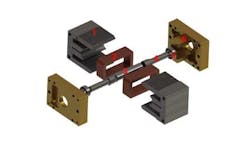Rotary actuator for laser scanners lowers costs by one third

Orlando, FL--Pangolin Laser Systems, producer of laser light show software and control hardware, introduced a low-power rotary actuator based on a dual-coil, segmented stator design. Long dissatisfied with the speed and control limitations of rotary actuators used in laser scanning and other optical and lighting applications, Pangolin says the new VRAD-1510 actuator significantly increases the speed, range of rotation, response, and precision of motor shaft movement while reducing the cost of the actuator by at least one third compared to existing devices.
Pangolin CTO and co-founder William Benner says the VRAD-1510, while designed for use in high-speed laser scanning and lighting gear, is sufficiently versatile for a wide range of electromechanical applications, including mechanical and automotive systems, industrial and commercial machinery, robotics, vending, HVAC, valve control, and other uses. Rotary actuators are also commonly referred to as rotary solenoids and torque motors.
"We developed a novel and inexpensive way of producing a segmented stator without air gaps, which interfere with a motor's magnetic field," said Benner. "Additionally, our design employs two, separately-accessible coils and several other innovations and quality features, resulting in a compact, very quiet, very durable, low-power actuator. Its linear angle versus current profile is a major advancement."
Benner says the VRAD-1510 uses a magnetic spring and pre-loaded precision ball bearings for extreme durability. The new design also precludes the need for mechanical stops on shaft rotation, all but eliminating noise, wear, and vibration while enabling a wider range of potential applications. The range of shaft rotation is greater than +/- 60 degrees from the neutral position and the actuator's coils may be driven in series, in parallel, or separately. "This opens up many options in how the device can be employed," said Benner, "For example, instead of using two coils to produce torque, one can be used for velocity sensing or dynamic breaking."
The actuator is also equipped with front and rear shafts, allowing multiple points of attachment or the use of an encoder or position sensor for closed-loop operation. Pangolin says the key innovation is the patent-pending stator design that uses a series of asymmetrical, interleaved laminations that are inexpensive to make, easy to assemble, and which fit together in a way that prevents the introduction of air gaps to the motor’s magnetic field. The VRAD-1510 is priced at $99.00; see www.pangolin.com/VRAD.
SOURCE: Pangolin Laser Systems; www.pangolin.com
About the Author

Gail Overton
Senior Editor (2004-2020)
Gail has more than 30 years of engineering, marketing, product management, and editorial experience in the photonics and optical communications industry. Before joining the staff at Laser Focus World in 2004, she held many product management and product marketing roles in the fiber-optics industry, most notably at Hughes (El Segundo, CA), GTE Labs (Waltham, MA), Corning (Corning, NY), Photon Kinetics (Beaverton, OR), and Newport Corporation (Irvine, CA). During her marketing career, Gail published articles in WDM Solutions and Sensors magazine and traveled internationally to conduct product and sales training. Gail received her BS degree in physics, with an emphasis in optics, from San Diego State University in San Diego, CA in May 1986.